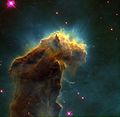Eagle Nebula
| Emission nebula | |
|---|---|
 | |
| Observation data: J2000.0 epoch | |
| Right ascension | 18h 18m 48s[1] |
| Declination | −13° 49′[1] |
| Distance | 7,000 ly ly |
| Apparent magnitude (V) | +6.0[1] |
| Apparent dimensions (V) | 7.0arcmins |
| Constellation | Serpens |
| Physical characteristics | |
| Radius | 70×55 ly (cluster 15 ly) ly |
| Absolute magnitude (V) | -8.21 |
| Notable features | 5.5 million years old |
| Designations | Messier 16, NGC 6611,[1], Sharpless 49, RCW 165, Gum 83 |
The Eagle Nebula (catalogued as Messier 16 or M16, and as NGC 6611) is a young open cluster of stars in the constellation Serpens, discovered by Jean-Philippe de Cheseaux in 1745-46. Its name derives from its shape which is reminiscent of an eagle. It is the subject of a famous photograph by the Hubble Space Telescope, which shows pillars of star-forming gas and dust within the nebula.
Characteristics
The Eagle Nebula is part of a diffuse emission nebula, or H II region, which is catalogued as IC 4703. This region of active current star formation is about 7,000 light-years distant.
The brightest star in the nebula has an apparent magnitude of +8.24, easily visible with good binoculars.
'Pillars of Creation' region

Images made in 1995 by Jeff Hester using the Hubble Space Telescope greatly improved scientific understanding of processes inside the nebula. One of these, a famous photograph known as the "Pillars of Creation", depicts a large region of star formation. Its small dark areas are believed to be protostars. The pillar structure of the region resembles that of a much larger star formation region, imaged with the Spitzer Space Telescope in 2005, in Cassiopeia, which is designated W5 and has been dubbed the "Mountains of Creation".[2]
Combinations of an X-ray images from the Chandra observatory with Hubble's "Pillars" image have shown that X-ray sources (from young stars) do not coincide with the pillars, but instead randomly dot the area.[1] This suggests that star formation may have peaked approximately one million years ago in the Eagle Nebula and any protostars in the pillar's EGGs are not yet hot enough to emit X-rays.[citation needed]
In early 2007, scientists using the Spitzer discovered evidence that the Pillars were likely destroyed by a nearby supernova explosion about 6,000 years ago, but the light showing the new shape of the nebula will not reach Earth for another millennium.[3]
In fiction
-
An infrared view of the pillars reveals different structures. CreditESO
External links
- SEDS Messier page on M16
- Hubble telescope images on M16
- The Eagle Nebula on WikiSky: DSS2, SDSS, GALEX, IRAS, Hydrogen α, X-Ray, Astrophoto, Sky Map, Articles and images
- M16 The Eagle Nebula
References
- ^ a b c d "SIMBAD Astronomical Database". Results for NGC 6611. Retrieved 2006-11-16.
- ^ Spitzer Captures Cosmic "Mountains Of Creation"
- ^ Famous Space Pillars Feel the Heat of Star's Explosion - Jet Propulsion Laboratory



